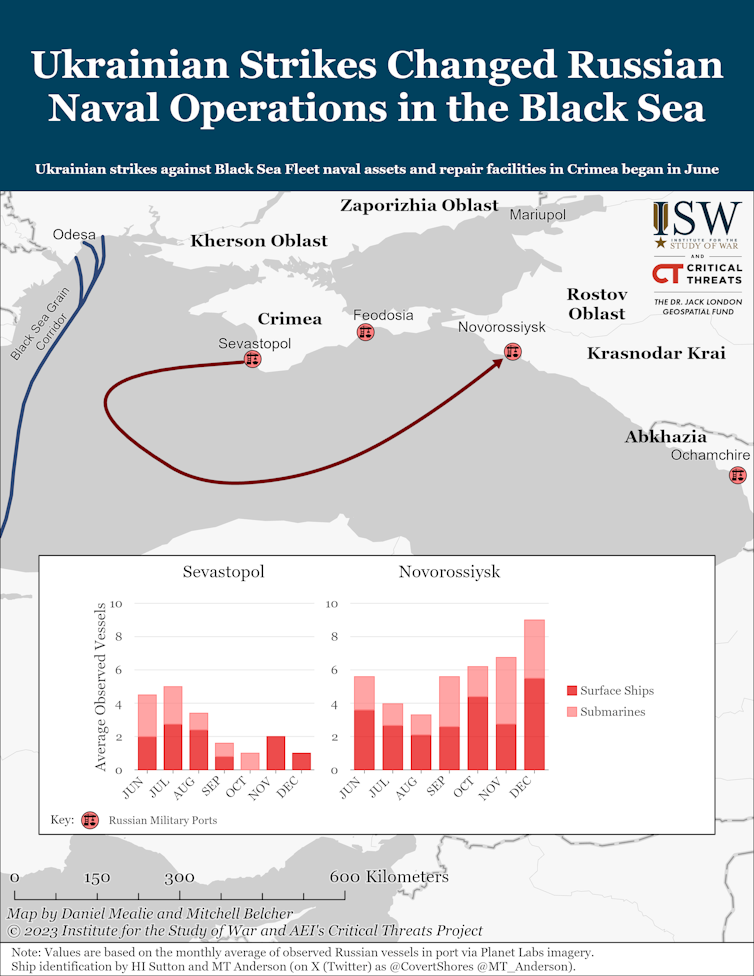The last few days marked a significant moment in the naval war between Russia and Ukraine. On Monday, July 15, Ukrainian Navy spokesman Dmytro Pletenchuk claimed: “The last patrol ship of the Black Sea Fleet of the Russian Federation is just leaving our Crimea. Remember this day.”
This symbolic milestone is a reminder of Ukraine’s continued successes on the naval front of the war. While Kyiv’s ground forces continue to fight and have to clear ground in some parts of the battlefield, especially in eastern Ukraine, the situation at sea is different.
Although Russia’s Black Sea Fleet had enormous numerical superiority at the beginning of the war, it was unable to make a significant contribution to the war. Moscow has lost control of the Black Sea, and even the ports of Crimea – including Sevastopol, traditionally a symbol of Russian power – are no longer considered safe bases for its warships.
A decimated Black Sea fleet
Ukraine does not have an operational navy—it has no large surface warships or submarines, just a handful of small patrol boats. Yet Kyiv has developed a credible capability to destroy Russia’s warships with missiles and maritime drones at long ranges—as far away as Crimea. This is a vivid example of the changing nature of naval warfare and the growing power of asymmetric weapons—weapons that cost much less to produce than the warships they destroy.
This is a big problem for Russia, because warships are among its most expensive military assets, with a procurement cycle that can stretch for decades. And Vladimir Putin’s decimated Black Sea Fleet cannot be reinforced with warships from Russia’s other fleets because Turkey applies the Montreux Convention, which was signed in 1936 and regulates maritime traffic through the Bosporus and Dardanelles in Turkey. Among other things, warring states are not allowed to cross these straits with warships.
Moscow has no choice but to protect its remaining warships in the Black Sea, which explains the frequent “redeployments” further away from Crimea – especially to the port of Novorossiysk.
Dwindling operational options
With Russian surface warships unable to operate safely, especially in close proximity to Ukraine, some operational options – such as an amphibious assault on Odessa – are no longer an option. Even supplying logistics to troops on land is proving challenging, while Moscow’s ultimate failure to blockade Ukraine – particularly its grain exports – was crucial to maintaining the Ukrainian economy.
Russia’s Kilo-class submarines are still relatively safe underwater and can launch Kalibr cruise missiles against targets in Ukraine. However, these submarines are unlikely to be decisive in Russia’s air campaign against Ukraine’s energy and civilian infrastructure, as their offensive threat is small compared to Ukraine’s resilience to damage. However, they can still make a limited contribution to the overall threat posed by Russia to Ukraine’s air defense systems.
On a symbolic level, Ukraine’s successes at sea are a political blow for Putin. Crimea plays a central role in Putin’s narrative of reviving Russia as a “great power” that bolsters his regime at home.
At the same time, Ukraine’s numerous successes against the Black Sea Fleet are boosting morale at a time when it is becoming increasingly difficult to motivate Ukrainian soldiers who have been fighting on the ground for long periods without seeing any “concrete” progress. The symbolic value of these successes should not be underestimated in the context of a long war of attrition.
Crimea as a turning point?
For the past 12 months and more, the focus of the war has been on land, where Russia has made steady, incremental progress. But Ukraine’s consistent successes at sea are significant, adding to a trend that began with the sinking of the cruiser Moskva in April 2022 and the recapture of Snake Island in July 2022. In total, Ukraine has destroyed or seriously damaged at least 27 Russian warships.
This is not just a victory against Russian naval forces: these successful attacks must be seen in the context of the broader strategic, operational and tactical developments of the war in Crimea.

Institute for War Research
The pressure on Crimea is strategic. Kiev is targeting naval facilities, air bases and air defense systems, as well as transport infrastructure, including the Kerch Bridge – a vital supply route to the peninsula for Moscow. These attacks are being reinforced by the use of long-range missiles from the West.
This effectively forces Russia – for which the loss of Crimea or even a serious setback there would have catastrophic consequences both militarily and politically – to operate on two fronts.
On mainland eastern Ukraine, particularly in the Donbass region, Russia enjoys enormous numerical superiority. But in Crimea, where Ukraine can implement an agile strategy while making the most of asymmetric technologies, Russia is increasingly on the defensive. And these successes in the Black Sea and Crimea may divert Russia’s attention and resources from the land front.
Ukraine’s “naval victory” will not directly help its ground forces – at least not for now. But any significant breakthrough – if, for example, Kiev succeeds in finally destroying the Kerch Bridge – could decisively change the course of the war.




